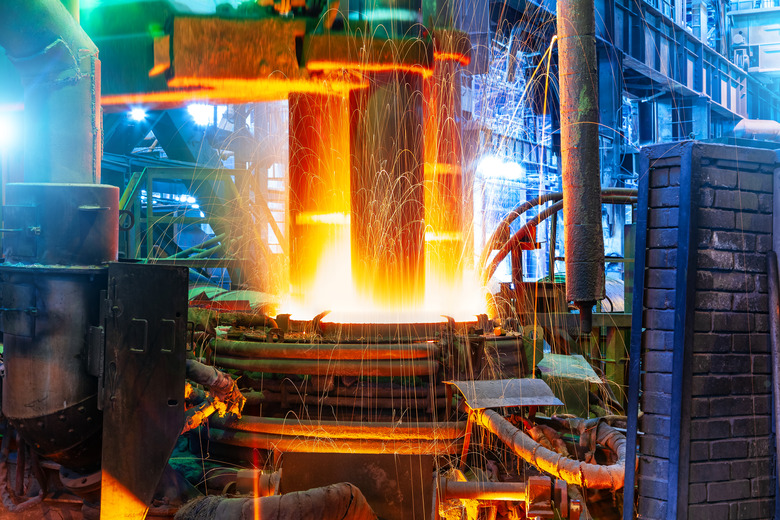How Does An Electric Arc Furnace Work?
Electric arc furnaces (or arc furnaces) are high-temperature furnaces that use high-voltage electric currents as their primary heating element. Invented in France in 1907, these furnaces are a crucial part of iron and steel recycling operations. They're featured in "mini-mills" that recycle iron scrap for reuse. Arc furnaces are also used in the production of steel. The design of these furnaces makes them simple enough to be built at home by hobbyists as well.
Tip
An electric arc furnace uses a high-voltage electric current that arcs between graphite electrodes to generate heat.
Four Furnace Types
Four Furnace Types
There are four primary types of furnaces used in foundries today: cupola furnaces, induction furnaces, crucible furnaces, and electric arc furnaces. Each of these uses different methods to complete the same general task — melting down metal or scrap metal with incredible amounts of heat so it may be shaped and used for everything from construction to electronics to common household goods.
The specific uses of each furnace type depend on the way it works as well as what its primary heat source is. Cupola furnaces, for example, are heated through the the burning of coke, coal, and limestone fuel, making them primarily suitable for processing iron ore, while induction and crucible furnaces, heated with electrically charged copper coils and hot plates, respectively, deliver an efficient and controlled heat that makes them perfect for working with metals like brass, aluminum, copper, and gold.
Electric arc furnaces act as a sort of middle ground. By using both electricity and, optionally, solid fuel as their heat sources, they can process both scrap iron and iron ore to make steel.
Arc Furnace Components
Arc Furnace Components
An electric arc furnace is essentially a giant heat-resistant kettle powered by three graphite spikes. The furnace has a removable water-cooled lid that holds the graphite spikes and is connected to large power lines that act as electrodes. When the lid is raised, the furnace can be loaded with any combination of iron scrap, iron ore, flux, and solid fuel, and when closed and secured tightly, the electrodes can be lowered into the scrap to begin the melting process.
Melting Down Metal and Ore
Melting Down Metal and Ore
Arc furnaces melt down scrap and ore through the use of their graphite electrodes. When power is fed into the furnace, the electricity jumps between the two energized electrodes and into the neutral, grounded electrode. The high-voltage electric arcs created by these graphite spikes give off large amounts of direct and radiant heat that melt the contents of the furnace.
If solid fuels have been placed into the furnace as well, the heat from the electrodes transfers to the fuel and sets it alight, increasing the overall heat. When the molten metal is ready for use, it can be drained through a special port on the furnace for casting and forging. The entire process can take as little as an hour.
Arc Furnace Drawbacks
Arc Furnace Drawbacks
Though arc furnaces are useful and can process large amounts of scrap metal in a relatively short amount of time, their traits give them a few downsides that must be considered before using them. More than anything else, arc furnaces use an incredibly large amount of electricity — to the point that industrial arc furnace use has been known to make power flicker in an area, so use times are generally keyed to periods during which electricity isn't being widely used. Like other furnace types, they are also loud and require a nearby steel mill or other metal-processing plant to effectively utilize the products produced within.
